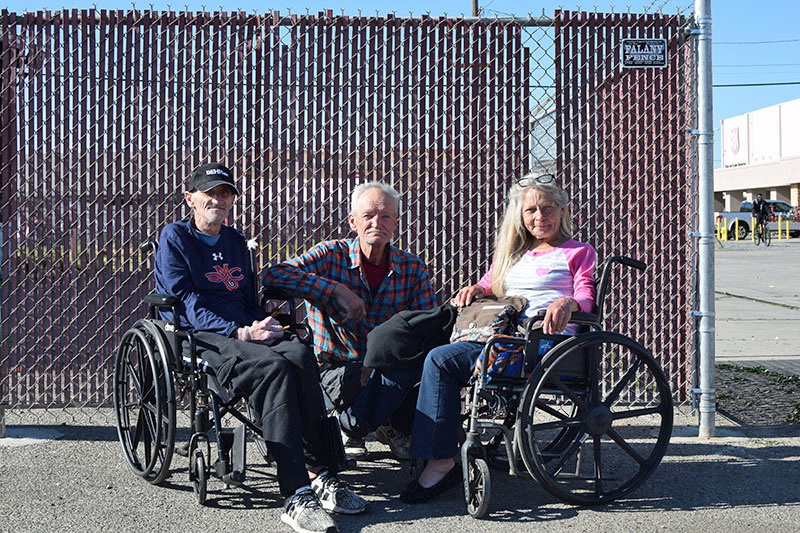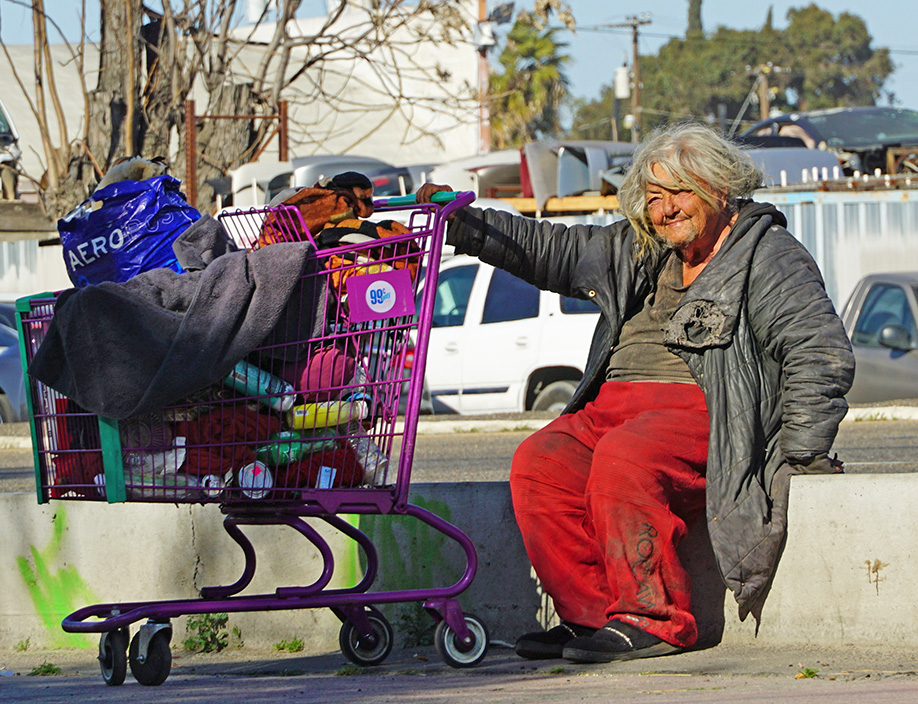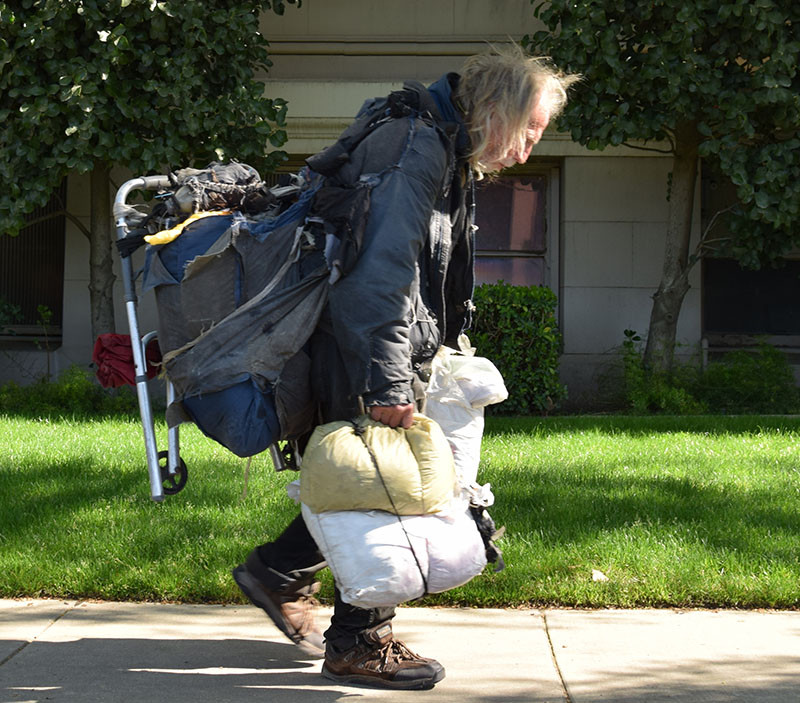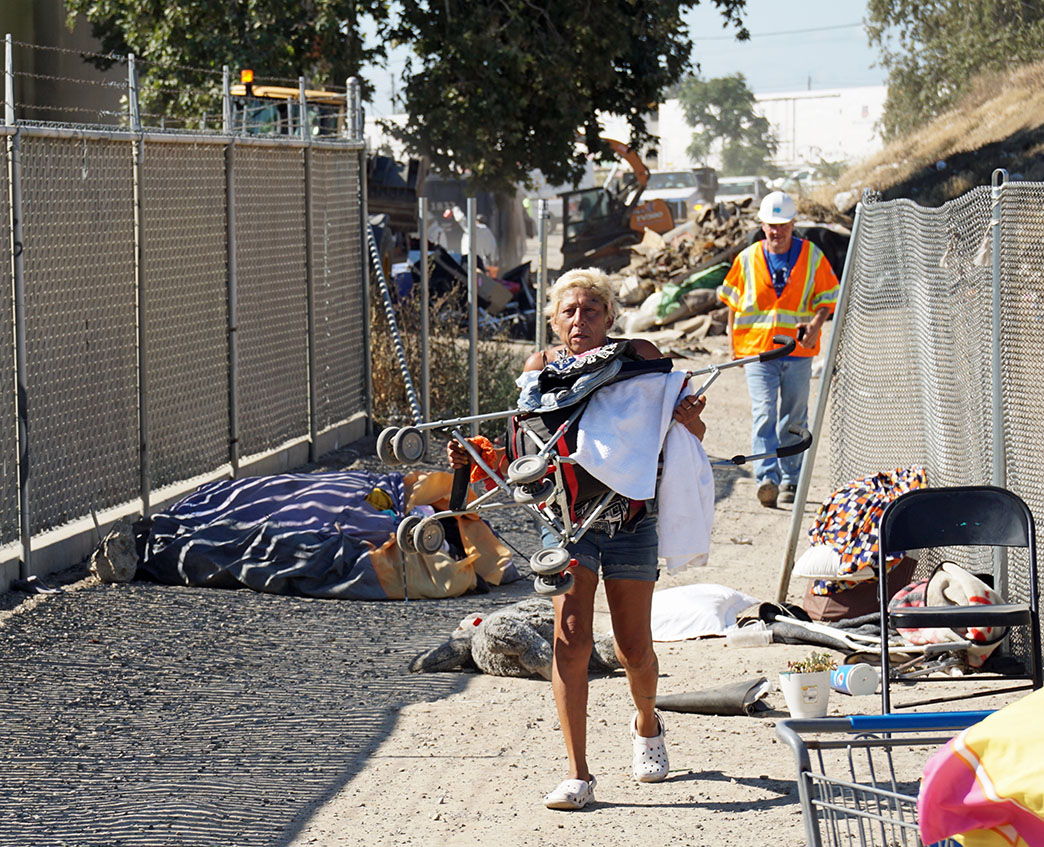The name “Larry” below is a pseudonym. He’s still on the streets, last we knew. ed.
I walked into the camp thinking I’d done as much as I could to be safe. Still, I felt twinges of fear. A few years ago, before the systematic sweeps of camps throughout the city and county, I’d usually find a friend to accompany me into the roughest camps. The friend would always be someone who was homeless himself or had been and was trusted among the homeless.
I also always surveyed camps before entering, sometimes for a few weeks. I would look for people I knew, or for indications of who might be the camp shot caller. Most camps larger than three tents or tarps would have a shot caller — the person who laid down the informal rules for the camp and made sure they were enforced.
Years ago the camps were bigger. That was before authorities in Modesto and Stanislaus County joined Caltrans in systematic sweeps of homeless camps, despite court rulings that such sweeps were a form of “cruel and unusual punishment” for people having nowhere to go other than public property.

This camp was in an alley in one of Modesto’s poorest neighborhoods. It was one of those zombie camps that always returns a few days or weeks after it’s been swept. I had visited the site before, but that was when I could enter from a busier and more visible street. This time, because the camp was much smaller and deeper into the alley, I had to enter from an adjoining alley.
The only time I’d ever had any trouble near a camp was when I left my camera on the passenger seat of my car while on a short visit to a rough camp on Caltrans property near Modesto. That time, someone broke the window and took the camera. I later learned the thief was a passerby, not a camp resident. It’s very likely the theft would never have happened had I taken my usual precaution of stowing the camera out of sight.
This time, I made sure I parked where I could see my car, though it was unlikely someone would break in, given the comings and goings of people in the neighborhood. I also had a name of someone who was well known to the local homeless population, many of whom I myself knew.

“Anyone seen Larry,” I said, as I walked up to two elderly men standing in front of a line of blue and brown tarps tied to a chain link fence that ran down one side of the alley.
“He’s right here,” said one of the men, as another voice said, “I’m right here.”
I looked down and saw Larry, no more than four feet away, lying amidst the clutter of a small barbecue, a couple of bicycle wheels, a pair of jeans, and refuse, mostly food wrappers.
Larry spends a lot of time on the ground because it’s difficult for him to stand up. He’s had two broken necks and various other debilitating accidents, one of which led to a case of necrotizing fasciitis that almost cost him his right arm. He can stand unassisted and get around with a cane, but it’s difficult.

I was checking in with Larry to see how he was doing after losing his bed at one of the local shelters. He was one of many homeless people who find it difficult to stay in a shelter more than a few weeks at a time.
This time, he was evicted from the shelter after missing bed check. Larry claimed that he missed the bed check because he’d been robbed and spent time tracking down the culprit and getting help from the police.
I was relieved to find Larry was still the resourceful and tough person I’d known over the preceding three or four months. He’d been on the streets for over five years. Despite his disabilities, he managed to maintain his bicycle and a handmade cart for his belongings. He also managed to stay clean and optimistic, somehow.
As I did a casual survey of the campsite, I realized the few residents were mostly old men. There was one younger man a couple of tarps down. I then reflected on the actual demographic of homeless people in California, even while realizing I had never really been threatened or in danger from homeless people, especially those in an encampment, however large or small. Mostly, I’d been surprised at how many people in the camps were harmless and vulnerable.
The number of disabled and elderly people in the homeless population is striking. One volunteer outreach worker in Modesto referred to local shelters as “infirmaries” because so many of the residents were elderly and disabled.

Studies in 2023 revealed the fastest growing segment of California’s homeless population “were adults 50 and over.” According to the California Budget and Policy Center,
“…experiencing homelessness at any age is severely destructive to an individual’s well-being, older adults are the fastest-growing population experiencing homelessness and the largest share of individuals who are encountering homelessness for the first time in their lives. Without swift and intentional policy action, California faces a future with a growing number of unhoused older adults as the state’s population ages.”
If we include mentally ill people in the homeless population, we find that a stunning 82% have reported a serious mental health condition at least once in their lives and 27% were hospitalized at least once for a mental health condition. Nationwide, over 40% of sheltered homeless people have a serious disability. When we combine the demographics of the homeless population — elderly, mentally ill, disabled — with California’s severe housing shortage, compounded by rising rents, we find that vast numbers of those experiencing homelessness are people in distress who can’t achieve self-sufficiency due to material factors beyond their control.
Given these well-established facts, no one should be celebrating the United States Supreme Court’s recent decision to permit sweeps of homeless camps even when there are no alternatives available for the residents of those camps. Escalating penalties and punishment for people in distress is like tossing an anchor to a drowning person.
From the very beginning of the homeless crisis, when people on the streets were demonized for “choosing” homelessness, we’ve failed to acknowledge the facts that have driven people out onto the hard ground of distress. Homelessness is a humanitarian crisis. So is punishing the elderly, sick, and disabled for circumstances beyond their control.

I am 66 years old, fighting cancer and been homeless for 9 months. My rent was raised to more then I make on s.s.d.i.
Great article Eric, it’s a HOT one just like our weather.
The statement “Homelessness is a humanitarian crisis” has been used for sometime now but for some reason it doens’t seem to generate enough direct action to minimise homelessness. I wondered why, so I thought I’d put my personal AI assistant Claude, to the task and ask: what is the essence of this statement.
Claude says: It conveys that homelessness is a severe, widespread problem that urgently requires action to address human suffering and protect basic human rights and dignity. This characterization implies several key points:
1. Scale and severity: It suggests that homelessness affects a significant number of people and causes serious harm to those experiencing it.
2. Human rights issue: It frames homelessness as a violation of fundamental human rights, such as the right to shelter, safety, and a decent standard of living.
3. Urgent need for action: Labeling it a “crisis” emphasizes the pressing need for immediate and comprehensive responses.
4. Systemic problem: It implies that homelessness is not just an individual issue but a societal failure that requires collective action to address.
5. Complex causes and effects: Like other humanitarian crises, homelessness is often the result of multiple factors (e.g., poverty, lack of affordable housing, mental health issues) and has far-reaching consequences on health, safety, and social inclusion.
6. Moral imperative: It suggests that addressing homelessness is not just a matter of policy but a moral obligation for society.
By framing homelessness as a humanitarian crisis, advocates aim to elevate the issue’s importance and urgency in public discourse and policy-making.
**End Claude**
With this deeper understanding, is the problem then related to the fact that we have become numb to crisises unless we are directly involved? When I was a kid in a small town and the fire siren when off, we did our best to get to the scene and help if we could. Today the sirens go off and irritate us because it’s just one more thing we have to deal with in our already complex lives. It seems for many, the homeless are sirens that just need to go away.
How did we lose our way??? Can we get back on a kind and compassionate path?
The rampant homelessness is a symptom of a bigger problem of socioeconomic decay and collapse. To solve the homeless problem would mean we as a society must acknowledge the systemic failures of our socioeconomics and culture. Collectively we aren’t willing to do this . It would push too many people out of their comfort zone . It’s so much easier to blame the victims than doing the real work of confronting ourselves; who we are as a society and our moral failings. We’ve shown our values and it is ugly. Supreme Court ruling just reflects this. Not absolving them of their role in perpetuating the problem.
Unless there is a fundamental change in our values (and valuing compassion would be a good start) , nothing is going to change and homelessness will increase.
Beautiful Mary.
Frank:
It is clear that A.I. Claude is one smart dude! Such clear analysis and understanding are beautiful. But that reminds me of Che Guevara’s grand reminder, “Words are beautiful but action is supreme.”
Action depends on awareness plus caring…
“Action depends on awareness plus caring…” and its the caring for our neighbors that we need. Remember, “There Are No Others” in Stanislaus county!!
It sounds like we need to identify the obstacles to providing decent shelter for those who want it. Councilmembers Ricci, Bavaro and Alvarez have stated several times their desire to provide such shelter. The Modesto Peace/Life Center is actively seeking ways to provide shelter. So why are their efforts being thwarted? Is it possible to form a coalition of interested parties to work together – City, County, non-profits, homeless advocates – to make progress on providing a variety of shelter options?
tonight I believe I saw larry on I street. Gave him a little money. no water with me. He looked just like picture here. The sweat was poring off him and he was red in the face. He said nothing nor did I expect him too. Seeing him was just one more depressing thing to cap a disturbing day. No fault of his but show placed the reality we seem to be living in today.
I was at the Modesto City Council meeting. A meeting full of things like a Latino man, Spanish speaking only, trying to organize his workplace fellows into a union and terminated because of that. NVLF there to add their bit and try to relay, to the CC, the seriousness, but mostly it seemed, the council didn’t know what to do. They don’t answer questions at these meetings per rules?. Another man, Sebastian Jones, it seems, was removed from a City board position and as of yet no reason given to him. J. Williams, CC, named by Sebastian, seemed to have something to do with it per conversation.. I spoke about the homeless because so far all efforts by groups engaged to help them have been bypassed by CC and county decisions to HELP are based on accepted NORMAL solutions for those people, homeless, who are not living in any form of normality nor normal circumstance in this supposedly civilized society. Another gentleman gave a public comment re: homelessness and the recent Supreme Court that sanctioned just about anything the City wanted to do to Homeless was OK. He didn’t agree one bit with that “anything goes” attitude and was very astute in his observations re: events, plans, ideas rejected by CC, County already transpired, created as not helping. the people. They are people! Do something! Even many in audience seemed to be more vocal than usual and sounded off unexpectedly to the distress of Mayor and CC members. Left before comments done, but lobby TV was showing a woman, girl crying during a comment I guess as I was leaving meeting. They Mayor, CC, hadn’t got to the main agenda items yet.
Anita,
Could certain summarizations,
such as the following quote from an author, help to explain “why”:
“In…the domain of peasant politics… beliefs and actions did not fit into the grid of “interests” and “aggregation of interests” that constituted the world of bourgeois representative politics… The specific determinants of the peasant political activity remained incomprehensible from the standpoint of bourgeois politics.”
Partha Chatterjee, The Nation and It’s Fragments
The description of the latest City Council (CC) meeting, as offered here in this post, clarifies just how far removed CC members are for the most part, from the average concerned valley citizen. Some talk the talk, but when it comes to walking the walk, for the most part we hear crickets. Can’t ruffle feathers?
My quest is “why” is it a rule that we get a lousy 3 minutes to condense our heartfelt thoughts and feelings, before the social engineering, bourgeois, known as the CC, yet, mayor and members do not have to impromptu even the remotest of a heartfelt thought or feeling in reply?
These social engineer types design public meetings to further distance themselves from us. When are we going to have a larger say about the way we are heard and listened to?
We must gather to discuss what is necessary and how we shall go about obtaining such? ASAP!